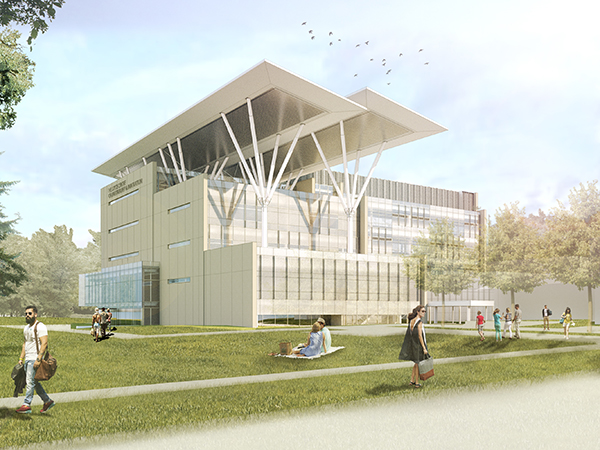A future with zero carbon buildings
A new framework has been launched to help existing and new buildings transition toward a zero carbon footprint.
Developed by the Canada Green Building Council (CaGBC), the aim of this standard is to encourage a large-scale market transformation toward zero carbon buildings. It applies to both existing and new buildings, commercial and institutional buildings, multi-family buildings and commercial warehouses.
Lire aussi : First commercial LEED v4 Platinum certified project in Canada
This new standard was developed as part of a pilot project in which 16 buildings (both under renovation or construction), were chosen from across the country to serve as examples of carbon neutrality. One such building is the new headquarters of the Toronto and Region Conservation Authority (top photo), a six-storey, 100,000-square foot, wood-structured building that will be designed to achieve zero carbon, LEED Platinum and WELL building certifications.

Mohawk College will be one of the largest zero-energy institutional buildings in Canada.
Another one of the buildings taking part in the pilot project is the Curé-Paquin Elementary School in Saint-Eustache, Quebec. The over 30,000-square foot building uses several passive strategies, including optimized natural daylighting and ventilation, and low carbon materials.
Lire aussi : First sustainable development report in the architecture field
Some of the other buildings included in the pilot project are Mohawk College in Hamilton (photo below), a fire hall in Vancouver and a post-secondary campus in Calgary.

Among the 16 pilot project buildings, this Waterloo office building is being certified as Leed Platinum.
“While there is no doubt that Canada’s building sector has been dramatically transformed over the last two decades, in particular thanks to the development of LEED certification, the time has come to be bolder and more ambitious,” explained Thomas Mueller, president and CEO of the CaGBC. “This new standard brings focus to carbon emissions reduction, and defines new levels of building performance.” The Zero Carbon Building Standard is a complement to the LEED program, also managed by the CaGBC.
The CaGBC launched the Zero Carbon initiative in support of Canada’s efforts to reduce greenhouse gas emissions by 30% by 2030, compared to 2005 levels. For the CaGBC, a zero carbon approach for new constructions may play an important role in achieving the objective, eliminating 7.5 megatonnes of GHG emissions annually.
Infolettre
Envoyée tous les jeudis.
Inscrivez-vous.
Suivez l’actualité de l’économie positive et engagée.
Emplois
Trouvez l'emploi idéal.
Événements
Nos prochaines activités.


